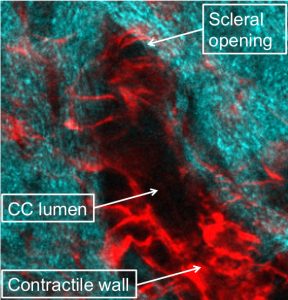IOP and the distal drainage tract
New discovery regarding outflow resistance in the aqueous drainage tract has significant treatment implications

Leigh Spielberg
Published: Friday, March 1, 2019
 Two-photon image of the collector channel. A significant
proportion of the channel cross-sectional area comprises
wall cells with filamentous actin (red). This leaves a
lumen (black oval) that is smaller than might be expected
relative to the opening in sclera (cyan)
Two-photon image of the collector channel. A significant
proportion of the channel cross-sectional area comprises
wall cells with filamentous actin (red). This leaves a
lumen (black oval) that is smaller than might be expected
relative to the opening in sclera (cyan) James Tan MD, PhD
James Tan MD, PhD